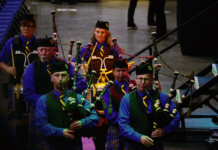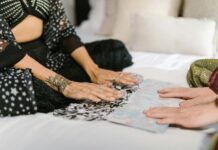
On a beautiful afternoon on Saturday, Feb. 9, a swarm of student attendees ran up and down the stairs of the HUB to their perspective workshops during ASPB’s third annual Sum of All Equals Change conference, covering topics ranging from the subculture of “hipsters” to campus climate. The day was composed of four sessions, with a one-hour lunch break in between. Each session featured three to five workshops each, which were hosted in different rooms in the HUB.
The 2013 Sum of All Equals Change conference aimed to bring awareness to many problems relevant to UC Riverside’s student population. HUB 302, where the first lecture was held, was set up like a banquet: complete with round tables, a slide show, and pumping feel-good alternative rock music from bands like Imagine Dragons and Phoenix. Free drawstring bags were handed out to all registered participants filled with a pamphlet summarizing the day’s agenda, a Sum of All Equals Change pin, as well as an adorable eco-friendly notebook and wooden pen, all branded with the conference’s logo.
At 10 a.m. William Ibekwe and Jared Mitchell, directors of the Contemporary Culture department of ASPB, welcomed participants to the event that they had slaved over for several months. Associate Director of Student Affairs for University Honors Scott Silverman then followed as the keynote speaker. He opened by sharing with the audience that he was a “big believer in the students.” His lecture aimed to show students how to unlock their passions and achievements by putting aside just 10 minutes a day. Silverman encouraged students to actually pursue the changes they want to see, instead of just complain about them.
“Not that I’m asking all of you to protest or anything,” he joked. However, his recommendations did not stray far from that realm. Silverman has had a long history at UCR (about 15 years) and has seen magnificent changes take effect. For example, he compared the shabby facilities of the past, such as a tiny learning center that was beyond falling apart, to the resources the campus has now—the HUB. By demonstrating how a small group of frustrated students managed to petition and gather 1,500 signatures, which was a big deal for a then-population of just 9,000 students, Silverman proved his point about student potential for action. The following slide displayed a quote by Margaret Mead: “Never doubt that a small group of thoughtful, committed citizens can change the world; indeed, it’s the only thing that ever has.”
After receiving a round of inspired applause, he paused to identify with student attendees. “There’s nothing special about me,” said Silverman. “All I know is that I saw a problem, and I asked myself what I could do about it.” He also shared that because the state does not fund student-use buildings, projects like the HUB depend on student fees. Since the survival of major improvements depend solely on student initiative, he opened up the panel and asked the audience what they wanted most to see change about their school. A few requests included longer library hours, more attention paid to safety concerns and more funding for Costo Hall on campus. Silverman reminded students to anticipate and be prepared for rejection. “People typically oppose change,” he said. However, because UC Riverside operates under a “shared governance” system, meaning that student committees and the university work together, students actually have more power than they think.
Silverman didn’t shy away from the problems that UCR students face today, such as the unequal ratio of food cost and food quality, parking and class limits due to budget cuts. The lecture ultimately encouraged students to go beyond remaining uncomfortable or quiet with what bothered them, and instead, actively pursue the appropriate steps to make a difference in their campus and community. Silverman provided a list of tactics, strategies and useful information to the audience which many of the attendees eagerly jotted down in their notebooks. He effectively broke down what was ideal for students into what was realistic in a series of very achievable steps. Still, he maintained that what happens after the students leave the conference depends on their own initiative as individuals.
After Silverman’s speech, the freshly motivated students were free to disperse into their respective workshops. The first session included three choices. The first choice brought awareness to queer invisibility in the Middle East; the second workshop was titled, “Freakin’ Hipster: Exploring the subculture everybody loves to hate;” and the third was a seminar on how to better approach, befriend and work with disabled people.
I chose to attend the second workshop, which was fully packed. The lecture was hosted by Tim Grove, chairperson of ASPB and a fifth-year media and cultural studies and theatre major. He began his workshop by asking the audience what they thought of when they heard the term hipster. Some sporadic answers included “big ol’ square glasses without rims” or “pretentious about everything,” both which triggered hearty laughter from the audience. Then he asked, “Does anyone identify as a hipster?” No one said anything.
This then led to the question of exactly what connotations are associated with hipsters. Some positive ones include good taste in music and interest in witty banter and philosophy. Some of the negative ones included arrogance as well as denial of their own identity. However, Grove asked this: “Can we ever truly identify something that doesn’t identify itself?” For example, if someone says that they are not pretentious, then one could argue that they are being slightly pretentious. Could the same be applied to hipsters?
Another attack of hipsters is the trademark irony in their fashion. For example, they are known to wear clothes that are so ugly and outdated that they somehow become endearing and unique. “Any hate is damaging,” said Grove. “But why do we hate hipsters?” After some struggle with the topic, the audience came to the conclusion that hipster fashion can be offensive when it borrows certain ideals without actually embodying them. Grove gave an example of a wealthy white individual wearing Native American patterns without actually knowing anything about the cultural history, and “growing a mountain-man beard without ever touching an axe in his life.” Grove went on to expand about a society of consumerism that fetishizes certain concepts, manifesting in material products and thus leading to this subculture of hipster that is everchanging.
Session two offered five workshops. The workshop topics included the impact of “Trap” and “Drill” music as related to the experience of the black community, the relationship between critical thinking and confidence, the difference between pursuing a degree and pursuing a career, the media’s distortion of body image and beauty and a workshop exploring sexuality.
I followed the giggles and rapid scurrying of attendees toward the fifth workshop. Hosted by Vincent La and Alex Chan, who are both med school students, their workshop titled “Let’s Get it On” was probably one of the most controversial and exciting topics of the day. Walking in, the first images to strike people were a desk displaying a variety of sex toys, and the walls were covered in post-its with titles like anal sex, drugs, STD’s, love and polygamy. The hosts began the ultimate icebreaker by asking each participant to introduce themselves as well as their favorite sexual position or one that they were curious about. Despite a few shy people, most participants openly answered.
“This is a safe space,” reassured La. Both La and Chan made the audience laugh but remained professional and very knowledgable about the body, being in the medical field. The hour was filled with close identifying, laughter, sincere questions and sharing personal experiences. Participants walked out in good spirits with better knowledge and more awareness about safe sex, which extends beyond protection and also includes notions of respect, honesty and communication with a sexual partner.
Vincent La came up with the concept as well as the logo for the Sum of All Equals Change conference since its first debut in 2011. “This is my brainchild,” he said. “Everything you see here has a little bit of me behind it.” He was passionate about the idea of students educating each other, did plenty of research and watched documentaries before pitching the idea to the rest of ASPB. “I never anticipated a second one, let alone a third,” said La.
After Session two, ASPB provided a hearty lunch of falafels and wraps from Extreme Pita, as well as bags of chips and water for everyone. HUB 302 was filled with chatter, heated debates and networking. Vice Chancellor of Student Affairs Jim Sandoval and Dean of Students Susan Allen Ortega walked around, chatted and sat with participants at their tables. Lara Repko, a freshman English major, showed initiative and came out to support the conference. Repko, a huge supporter of UCR’s events and activities, wanted to experience the conference so that she’s “not always sticking to [her] comfort zone in the dorms.” In reference to all these students coming as strangers and leaving with new knowledge and friendships, she said, “I think it’s so amazing.”
After lunch, session three kicked things back into momentum with topics such as stereotypes and social justice, Mexican culture and Mariachi musicans, the media’s representation of the LGBT community, an open mic performance and the socio-political consciousness in entertainment.
I joined the third workshop, which was hosted by UCR’s LGBT Resource Center. The discussion centered upon the problem of the mainstream media’s under-representation of the LGBT community as well as their lack of a realistic portrayal of it. Members are often utilized simply for comedic relief, occupational stereotypes or one-liners. Another detriment is that they are also typically attractive, wealthy and express ideas of homonormativity: a preconceived notion of what LGBT folks should look like or act like. Just a few minutes in, the audience took over and had a heated debate about LGBT community’s role in the media. After the seminar, participants left with plenty of useful contact information to get involved, keep discussing and spread awareness.
The final session consisted of four topics. The first explored how college might be teaching students to see the world in a one-size-fits-all perspective while the second introduced how students could make a difference through the ASUCR Senate. The third explored student leadership and potential on campus and the fourth was a series of games and exercises building trust and teamwork. Once students completed their workshops in the fourth session, they reconvened in HUB 302 for closing keynote speaker Chaplain James Yee, a former U.S. Army Muslim Chaplain. Yee witnessed religious abuses against prisoners in Guantanamo. Because of this, he has developed a passion for spreading awareness and preventing crimes and prejudices against American Muslims.
2013’s Sum of All Equals Change was an opportunity for ambitious students to utilize their power and bring about the changes they want to see most. Students left on Saturday afternoon with smiles on their faces, pins on their shirts and a newfound appreciation for their own potential.








